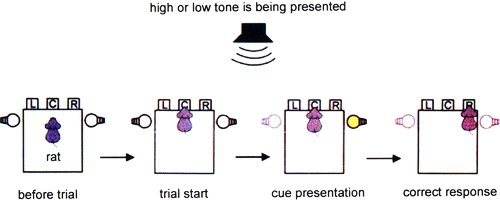December 3, 2013

From left, Prof. Sakurai and Mr. Terada
The research group of Satoshi Terada (Graduate Student, Graduate School of Letters), Yoshio Sakurai (Professor, Graduate School of Letters), and Susumu Takahashi (Associate Professor, Doshisha University) found that fast rhythmical activity of amygdala and hippocampus exhibits strong synchrony when the animals behave quickly and correctly based on their high expectation of reward.
This report was published in "Frontiers in Behavioral Neuroscience" on December 3, 2013.
Background
Expectation of future reward powerfully alters our behaviors. We often work and study more quickly and eagerly when we predict valuable and highly probable rewards. Such a phenomenon is emerged by the process that information of reward influences behaviors, and can be thought to be produced by neuronal communications between different brain regions, each of which plays a role of reward expectation or behavioral modulation. Little is known, however, about this communication mechanism because most of the previous studies watched only reward-related or behavior-related regions.
Here, the research group focused on electrical brain rhythms (oscillations) which reflect periodic fluctuation of activities of large groups of neurons. The oscillations in different brain areas have been reported to synchronize when these areas communicate their information with each other. The research group inferred that neuronal activities of reward-related and behavior-related regions should exhibit synchrony in oscillations when the animals modulate their behavior based on expectation of highly probable reward.
Methods and Results
The group simultaneously recorded neuronal activities from the amygdala and hippocampus when the rats were performing a behavioral task (Fig.1). This task required the rats to poke their noses into the right or left hole instructed by illumination cues. The type of continuously presented tone during the task was indicating probability of reward delivery (food pellet) when the rat made correct responses. The high and low tones meant that 80% and 20% of correct responses were rewarded respectively.

Fig.1: The behavioral task
First, the rats actually conducted correct responses more quickly and correctly in the high-tone presented trials, when they highly expected reward delivery, than in the low-tone presented trials. Second, differential activities of amygdala neurons reflected the different reward probabilities indicated by the high and low tones. Differential activities of hippocampal neurons, on the other hand, reflected the different behavioral responses to the right and left holes (Fig.2). Therefore, the amygdala neurons represented reward expectation and the hippocampal neurons represented behavioral modulation required in the task.

Fig.2: The activities of neurons during the task (left: amygdala, right: hippocampus)
Third, electrical activity (local field potential) from the groups of neurons of amygdala and that of hippocampus showed strong synchrony in their fast rhythms (high-frequency oscillation, 90 to 150Hz) when the rats highly expected the reward (Figs.3 and 4). As this synchrony appeared more strongly, the rats behaved more quickly and correctly in the task. These results suggest that synchrony in the fast oscillations intermediates neural communication between the amygdala and the hippocampus, which contributes to bind reward expectation and behavioral modulation.

Fig.3(left): An example of oscillations, Fig.4(right): Intensity of synchrony of the fast oscillations between the amygdala and the hippocampus during the task
Practical Application
The binding mechanism between reward expectation and behavioral modulation is possibly involved in volition and motivated behavior. Therefore bad condition of the binding may result in depression. The present result could contribute to progress of depression research from a point of view that the communication failure among the different brain regions underlies depressive behavior.
Future Study
Although the research group focused on the amygdala and hippocampus in this study, other brain regions, e.g., prefrontal cortex and striatum, should be considered for the future study. The group aims at uncovering the neuronal mechanisms of communication among these brain regions.
Paper Information
[DOI] http://dx.doi.org/10.3389/fnbeh.2013.00177
[KURENAI Access URL] http://hdl.handle.net/2433/179544
Terada Satoshi, Takahashi Susumu and Sakurai Yoshio
"Oscillatory interaction between amygdala and hippocampus coordinates behavioral modulation based on reward expectation"
Frontiers in Behavioral Neuroscience v.7:177 (2013)

